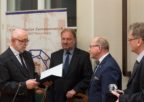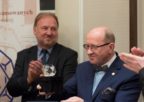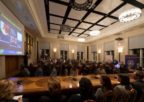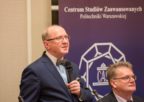The Council of the Center for Advanced Studies of the Warsaw University of Technology has awarded for the third time its most important Distinction Laus tibi, non tuleris qui vincula mente animoque, which this year went to Prof. Henryk Skarżyński. This Latin motto of the Distinction „Pythagoras Universe” is symbolized by the crystal dodecahedron; it is awarded for the achievements in building efficacious research spaces and breaking down the barriers of knowledge. The ceremony took place in the Senate Chamber of the Warsaw University of Technology on December 5th 2016.
Among important guests participating in the ceremony were Prof. Jan Szmidt, Rector of the Warsaw University of Technology, Prof. Krzysztof Zaremba, Dean of the Faculty of Electronics and Information Technology and Prof. Stanisław Janeczko, Director of the Center for Advanced Studies, who had greeted the Guests and presented the history and principles of granting this distinction.
– The Distinction of the Center for Advanced Studies of the Warsaw University of Technology Laus tibi, non tuleris qui vincula mente animoque meaning ‘Thanks be to You, who has not allowed to imprison his power of mind and spirit’ is awarded following the motion of the Chairman of the Council for the outstanding merits for the scientific community –said Prof. Stanisław Janeczko. – When considering the nomination we took into account candidate’s personal traits such as personality, independence, modesty, dedication, creativity, humility, education, energy. The statuette of the Distinction is a Crystal Dodecahedron symbolizing the crystal personality of a Master, because only a Master knows how to fill the void and is not imprisoned by matter, only a master can hear the harmony, know whence he comes, where he is and where he goes. – added Prof. Janeczko.
The laudation for the awarded Prof. Henryk Skarżyński presented Prof. Krzysztof Zaremba, Dean of the Faculty of Electronics and Information Technology who, as he himself frequently emphasized, has been honored to collaborate with the Institute of Physiology and Pathology of Hearing in many interesting innovative projects for many years: ‘This laudation will be different from what you are probably used to, because the Laureate is unique. (…) Profesor Skarżyński has so many accomplishments it is difficult to speak about them, especially in such a short speech. This is why I will speak about myself … Several years ago, on the initiative of the then Prorector of the Faculty of Electronics and Information Technology Prof. Jan Szmidt had been organized a meeting with the management of the Institute of Physiology and Pathology of Hearing and delegation of my department, which was dealing with biomedical engineering. At that time I did not put much importance to the meeting because my department had never been engaged in the issues of hearing, but I joined it with interest. This was my first meeting with Prof. Skarżyński, who had at the very beginning asked me what is the specialty of my department. I said, not very convinced that it would be of interest to anyone, that we specialize in imaging techniques, such as the magnetic resonance or the functional magnetic resonance. Then Prof. Skarżyński had asked me if it could be used in objective studies of hearing and neuronal processes responsible for hearing. I had answered positively. Prof. Skarżyński had listened to me attentively and when I had finished he proposed: ‘Let’s do it!’ So we did it. In 2009, in Kajetany had been opened the Bioimaging Research Center, which has at its disposal the super modern high field (3T) MR scanner and a specialized system for registering the EEG signal with 64 channel cap. The Center as the first one in Poland and one of the few in the world conducts research combining the maximum use of the advantages of the fMRI technique and the encephalography using the simultaneous fMRI-EEG registration method. This story shows the truth about Prof. Skarżyński – he is a visionary! He has great ideas that he then consistently realizes. He has a vision, looks to the future and realizes it! (…) Prof. Skarżyński is also a good engineer with perfect understanding of needs joining medicine with technical sciences and is able to cooperate smoothly with engineers. Finally, Prof. Skarżyński is an excellent organizer, of which the perfectly functioning Center in Kajetany is the best proof. Prof. Skarżyński is a man of many talents: he has made the architectonic sketch of the Kajetany Center himself, he wrote the texts for the word-and-music show prepared especially for the Jubilee of 25th anniversary of the program of treatment of deafness in Poland and 20th anniversary of the Institute of Physiology and Pathology of Hearing. Collaboration with Prof. Skarżyński is always an honor and pleasure!”
Rector Prof. Jan Szmidt, while presenting the Distinction to Prof. Henryk Skarżyński, had also made a reference to the collaboration between the Institute and the Warsaw University of Technology. This collaboration dates back to 1996. In 2009 the parties had signed another agreement of cooperation with elation to the implementation of technological solutions in otolaryngology, audiology and phoniatrics. Today, the Institute is cooperating with three faculties at the Warsaw University of Technology, which illustrates the width of joint endeavors.
– The term ‘Master’ used in this diploma, which I had a pleasure to sign personally, describes Prof. Skarżyński perfectly – added Prof. Szmidt. – He is the Master not only in his profession, but also a Master of making contacts in order to understand partners, because it is the best way to achieve something valuable.
Thanking for the award Prof. Henryk Skarżyński had underlined the special role of the cooperation with the Warsaw University of Technology in the entire history of the Institute. Many interesting examples of this extraordinary friendship between the medicine and engineering sciences were to be found also in the lecture presented by Prof. Skarżyński on “Hearing within the development of modern society – chances and risks”.









